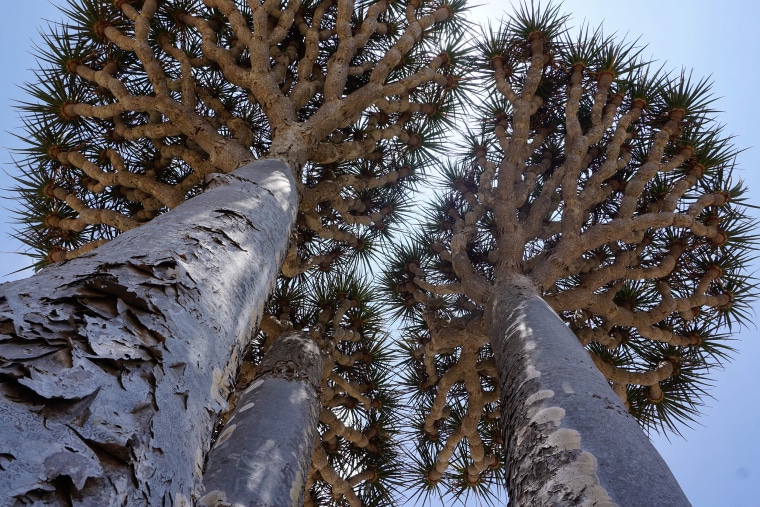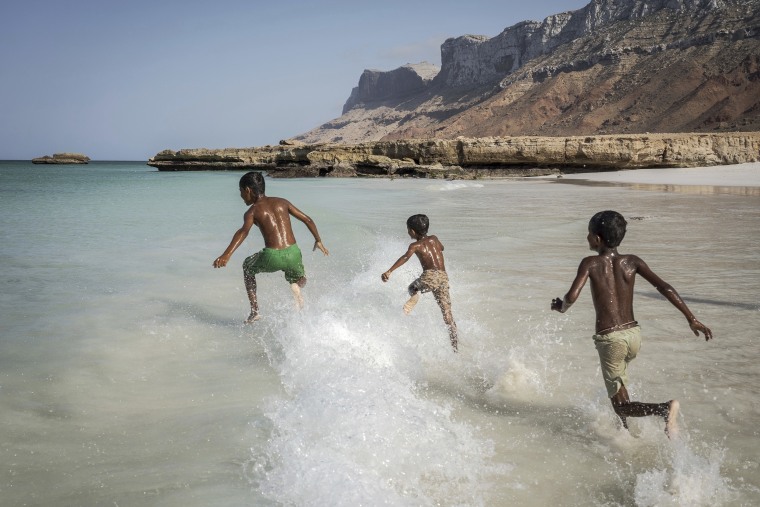Sitting off the Horn of Africa, the Yemeni island of Socotra was largely left to its own devices for centuries, its few guests arriving to trade for aromatic frankincense, the healing plant aloe and the crimson sap of the dragon’s blood tree, used for dyes.
Roughly the size of New York’s Long Island, Socotra is about 140 miles off the coast of Somalia, a remote location that has allowed a unique ecosystem to flourish. It has a rich array of bird and animal life, and the coral reefs off its shores teem with colorful marine life. One-third of its 825 plant species cannot be found anywhere else on Earth, according to UNESCO.
Some, including conservationist Kay Van Damme, have called it the Galápagos of the Indian Ocean and along with other experts, he is warning that millions of years of evolution on Socotra could be under “serious threat.”
“Climate change is by far the biggest threat to the island’s biodiversity,” Van Damme, who has worked on Socotra for more than two decades, told NBC News in a call last month. “It is a relatively small island with a predominantly arid climate. Even small additional impacts from climate change can have an outsized effect, putting further pressure on fragile ecosystems.”

Prolonged droughts brought on by climate change are compounding damage from devastating cyclones in 2015 and 2018 that destroyed reefs, eroded soil and uprooted rare plants.
The island’s lifeblood, endemic species of frankincense trees, are also under threat. Four of the 11 recognized species on the island were classified as critically endangered by the International Union for Conservation of Nature in March.
Five were recognized as endangered.“Their decline reflects the wider degradation of terrestrial habitats across the island and the ecosystems they support,” said Van Damme, adding that overgrazing — predominantly from goats — is another significant challenge, leading to habitat degradation and “leaving behind overmature trees with fewer younger trees to replace them.”
Tourism’s growing footprint
Attracted by Socotra’s pristine beaches, turquoise waters and surreal flora, tourists are also placing mounting pressure on the island’s fragile ecosystem.
While there is only a handful of hotels, mostly in the capital Hadibo, a growing number of tour operators offer luxury camping and 4×4 tours around the island, some of which are packaged as ecotourism.
Authorities have agreed to limit the number of tourists to around 4,500 per year, Ali Yahya, a local conservationist and tour operator, said in an interview last month, adding that when it came to “very sensitive areas in terms of ecosystems, biodiversity and cultural heritage, it’s strictly not allowed to build any big buildings or large-scale hotels.”
But despite Socotra’s UNESCO World Heritage designation — requiring preservation under international agreements — violations occur frequently, another local guide, Abdulraoof al-Gamhi, said in a series of voice and written messages last month.
“Some tourists build fires under dragon blood trees, carve inscriptions into rare trees, leave trash behind them and scare birds with their drones,” he said. But he added that many of the island’s residents benefit from tourism and that it is “very important” for “tour companies, car owners, drivers, restaurants, hotels and sellers of handcrafts.”
Echoing his concerns, Van Damme also said endangered species were “being killed just for a selfie,” with rare species like chameleons being captured so tourists can take pictures with them.
Al-Gamhi also said he expected the number of tourists to rise as more people discover the unique locale, and “that will put a lot of pressure on our environment.”
“It will be a big challenge,” he added.
A cautionary tale
Although the Galápagos comparison is often used to celebrate Socotra’s biodiversity, it can also serve as a warning, according to Van Damme, who co-authored a 2011 study on human impacts on the island.
Since the 19th century, the Galápagos, remote islands some 600 miles off the coast of mainland Ecuador known for their unique flora and fauna, have lost numerous endemic species to habitat disruption, overtourism and invasive species.
“Perhaps Socotran ecosystems,” Van Damme wrote at the time, “could now be considered as having at least, a similar state of health of those in the Galápagos at the time of [the Ecuadorian islands’] nomination as world heritage site 30 years ago.” He added that Socotra risked a similar fate without “timely conservation efforts.”

“If we consider the present-day condition in the Galápagos, we might catch a glimpse of Socotra’s future, or better, what could happen if trends and threats continue in parallel,” the paper added.
That assessment “turned out to be very predictive,” particularly in terms of climate change, he told NBC News.
The Galápagos Islands now host over 250,000 annual visitors, under strict controls including visitor caps, mandatory guides, designated trails and substantial tourism fees, which fund conservation.
Socotra needs to implement similar protections before damage becomes irreversible, Van Damme said.
Culture and tradition
Beyond the environment, there are signs that tourism is also eroding the island’s social fabric, according to Yahya, who said there was already a “cultural shift” among its 60,000 residents, many of whom remain deeply traditional and speak Soqotri, an ancient, unwritten language with pre-Islamic roots.
“International behaviors are influencing locals, and we worry about the erosion of our traditions,” he said, adding that while tourists were welcome, some of them needed to be more respectful.
An Instagram picture of a woman posing in a bikini beneath a dragon’s blood tree had upset residents of one mountain village, he said, adding that it was seen as highly disrespectful by the conservative residents.
Despite the pressures, there are reasons to be positive, Van Damme said, noting that authorities on the island are open to collaboration and local conservation projects are gaining traction.
“Community-led and other ongoing initiatives are vital,” he said. “As long as they continue, there’s genuine hope for the island’s future.”

Leave a Reply